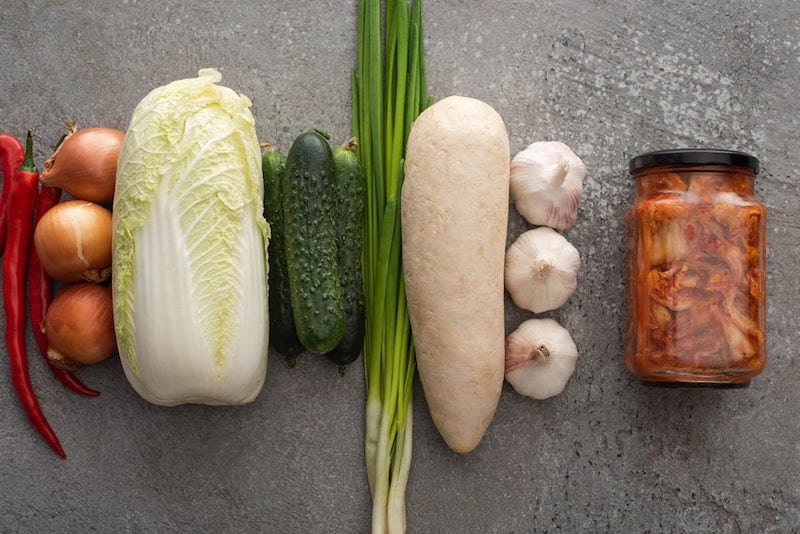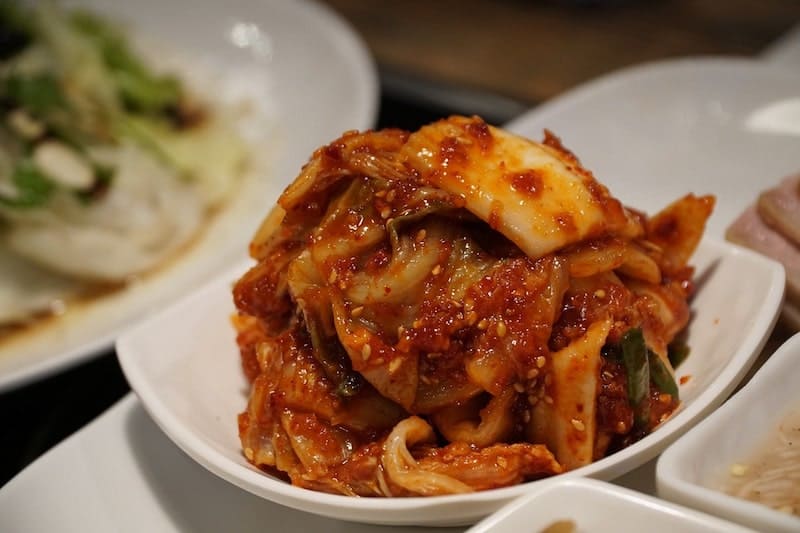Fresh Kimchi vs. Fermented: What’s the Difference
If you love international food, you’ve probably heard of kimchi, a traditional fermented Korean dish. Since kimchi’s been around for thousands of years, hundreds of varieties are now in existence. One of the most popular is fresh, unfermented kimchi.
If you’re wondering what the difference is between fresh kimchi vs fermented, you’ve come to the right place.
The obvious is that fermented kimchi has probiotics while fresh kimchi doesn’t. There are quite a few other differences included the Korean name for each, the taste, the appearance, whether or not it’s brined, and how it’s stored.
Read on for the details and everything you need to know about the differences between the two.
Name
Let’s start with the most fundamental difference: the name.
The most common type of kimchi is called ‘Baechu-kimchi.’ This is the fermented variety made with napa cabbage leaves.
But, of course, there are many other varieties of fermented kimchi: Bossam-kimchi, a type of wrapped kimchi; Baek-kimchi, that doesn’t contain chili pepper; Dongchimi, a non-spicy watery kimchi, etc.
Fresh or unfermented kimchi is called ‘Geotjeri.’ There’s also ‘Yeolmu-kimchi,’ which is made from radishes and doesn’t have to be fermented.
Taste
One essential difference between fresh and fermented kimchi is the taste.
Fresh kimchi is raw and fresh, similar to salads. When you taste it, you’ll notice the vegetables are crunchy and crispy. You can taste each vegetable individually.
On the other hand, fermented kimchi has a tangy, strong taste. This is because, during the fermentation process, the flavors of all vegetables mix and create a unique taste.
Due to this, fermented kimchi has a much stronger, sourer taste than its unfermented counterpart.
Appearance
Fresh kimchi looks more like a salad due to the lack of fermentation. Every vegetable used in fresh kimchi can be clearly distinguished. The spice paste doesn’t look blended with the vegetables; it looks more like a dressing.
Unlike fresh kimchi, fermented kimchi is more liquid, and all the ingredients are mixed together. In addition, due to the spice paste, vegetables often change color, rendering them almost indistinguishable on your plate.
Season
Fermented kimchi is usually made in the fall and winter. This enables you to store your kimchi at low temperatures, allowing slow fermentation and producing an exceptional flavor.
Fresh, unfermented kimchi is made in the spring and summer. Napa cabbage is in season then and can be used to create fresh, tasty salads. Summer napa cabbage is usually smaller, which makes it perfect for fresh kimchi.
Of course, there are always exceptions. You can enjoy both types of kimchi throughout the year, depending on your preferences.
Ingredients
Surprisingly, the ingredients of fresh and fermented kimchi are virtually the same.
The only difference is the amount of salt used. A smaller amount of salt is usually added to fresh kimchi. With fermented kimchi, salt affects the fermentation process, so it’s natural to add more.
As far as other ingredients go, there’s no limitation. So, for example, you can use the same ingredients for both types of kimchi.

Use
One of the differences between the two types of kimchi is their use.
When you make fresh kimchi, you eat it right away since the point is not to let it ferment. However, it’s excellent as a side dish and goes well with noodle soup, Korean barbecue meat, etc.
If you want to make fermented kimchi, you shouldn’t consume it right away. The fermentation process takes a significant amount of time.
Depending on where you store it, the process could last from a couple of days to a couple of weeks. So if you want fermented kimchi, make sure you plan in advance.
Fermented kimchi goes well with rice, porridges, rice cakes, etc. It’s also an excellent basis for other meals such as kimchi stew, pancakes, soup, etc.
Brining Time
Since we know the ingredients are almost the same, you’re probably wondering about the differences in the preparation process. The answer is: brining time.
Since it’s unfermented, fresh kimchi is meant to be eaten right away. Hence, the brining time is very short: 30 minutes to one hour.
The brining time of fermented kimchi is much longer. Since you have to prepare kimchi for fermentation, brining typically lasts from three to eight hours.
The fermentation process can last from a few days to a few weeks. There’s no exact time when your kimchi will be ready to be used. It depends on your preferences and the taste you want to achieve.
If you want a milder flavor, your kimchi will be ready in a few days if kept at room temperature. If you want a more pungent taste, you can keep your kimchi at room temperatures for a few weeks.
Storage
Depending on the amount of salt used, fresh kimchi can be stored in the fridge for about a week.
Fermented kimchi can be stored for much longer. If you keep it in the refrigerator, you can use it for around three to six months after opening. If you keep it at room temperatures, it will be good for two to three weeks.
Probiotics
The crucial difference between fresh and fermented kimchi is the presence of probiotic bacteria.
During the fermentation process, sugars and starches are turned into lactic acid. Lactic acid lowers the pH level, thus eliminating harmful bacteria. However, the acid also affects the flavor of kimchi which becomes stronger and sourer.
Fermented kimchi has an abundance of health benefits.
- It has an excellent nutritional profile, with a lot of vitamins and antioxidants beneficial for us.
- It contains probiotics, powerful microorganisms responsible for fighting different conditions and diseases.
- It boosts your immune system.
- It reduces inflammation.
- It has an anti-aging effect.
- It helps to fight off and prevent yeast infections.
- It can affect weight loss.
- It protects your heart and helps in preventing heart disease.
When it comes to fresh kimchi, the situation is a little different since it’s not fermented. Due to the absence of fermentation, there’s no room for the development of good bacteria.
However, that doesn’t mean fresh kimchi isn’t healthy. On the contrary, it still contains an abundance of vitamins and other valuable minerals such as vitamin A, riboflavin, iron, vitamin C, calcium, etc.
In Summary
Although the ingredients are almost the same, fresh and fermented kimchi are different in many ways. The crucial factors are the amount of salt used, brining time, and the presence of probiotic bacteria.
In terms of choice, it’s entirely up to you. Hundreds of varieties of kimchi allow you to choose the one you like best.







